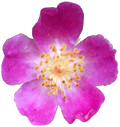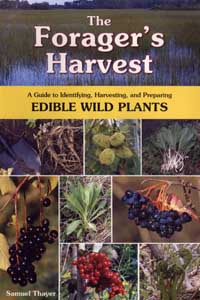Hopniss: North America's best wild tuber?
Also Known as Indian Potato or Groundnut
By Sam Thayer
From The Forager. Volume 2, Issue 3. Summer/Fall 2002
How thoughtful of the Creator to have designed such a plant as this: that on the banks of the rivers and lakes where for millennia the Earth-People have harvested their wild rice, a tuber grows in profusion which, combined with that grain, provides all the protein the body needs. How generous that such a tuber lies as a growing larder, providing food ready to harvest at any time of year. How lucky that such a food is not only easy to harvest, but delicious. How friendly and welcoming the woods feels to one who knows this secret: that a food called hopniss is waiting there.
There was a time, not unfathomably distant, when every woods-woman knew this plant. Settlements were located with its bounty in mind, and hopniss daily found its ways into the hearty dinners of a healthy people. This plant put forth a beautiful proposition: in exchange for starch and protein, women would loosen its soil as they dug for its riches and plant occasional tubers where they knew they would thrive. Generations may have forgotten, but this offer still stands.
Description: Hopniss (Apios americana) is a vigorously growing herbaceous vine that wraps around shrubs, small trees, and larger vines. It also sprawls across low vegetation and open ground. The vines grow from ten to twenty feet each season, dying back in the fall. The stems are thin and fragile-looking, about one-eighth inch in diameter or less, and thinly covered with very small hairs. Hopniss vines do not climb with tendrils (the coiled, thread-like branches that support grape and many other vines.) Instead, the entire vine of hopniss twines around and sprawls over its supports. Often, the vines grow profusely and form large, dense tangles.
The appearance of hopniss reveals its membership in the legume family; it looks much like an overgrown pea vine. The leaves are pinnately compound, often partly folded along the midrib. They consist of 5-9 toothless leaflets, 1-2 inches long, ovate to lanceolate. Hopniss flowers from July to September. The blossoms are purplish-brown and quite fragrant. They are borne in small, dense clusters. In late summer and autumn, 2"-5" pods appear, each containing a few seeds. Where I live, the plant never produces seed, but in the southern part of its range it does.
The hopniss plant has several edible parts. The flowers are fairly good raw or cooked, and the seeds are edible. These seeds are reported to taste like some sort of domestic legume, but since those in my area do not produce them, I have unfortunately never had the opportunity to confirm this or to elaborate on it. I have eaten the young, whitish shoots in the spring both raw and boiled, and have found them passably good but nothing worth raving about. Because they are so small and sparse, I have never been able to gather more than a small helping.
The most important edible part of hopniss, however, is its tuber. These are produced in chains of anywhere from two to twenty, spaced from less than an inch to more than a foot apart. The tubers are connected by a rhizome of variable thickness that is fairly tough but not quite woody. These rhizomes often branch and form an interconnected network under colonies of hopniss vines, but usually the rhizomes break into many pieces when they are extracted from the soil.
Hopniss tubers range from the size of a grape to the size of a grapefruit. They range in shape from spherical to extremely elongated to amorphous and knobby. Most commonly they are about one inch thick, one and a half inches long, and roughly egg-shaped. Tubers in their first year are generally rather smooth and light yellowish or reddish brown, with thin skin. Their surface shows scattered lenticels (like the eyes of potatoes) oriented perpendicular to the rhizome. On older tubers these lenticels develop into knobs, which grow erratically and sometimes become enormous. The skin on older tubers turns thick and leathery. A milky latex soon appears on damaged parts of the plant.
Name: Hopniss is known by an unusually large number of common names, including Indian potato, ground potato, potato pea, pig potato, bog-potato, wild bean, wild sweet potato, white-apple, pomme de terre, and, by far most commonly, groundnut. I have abandoned this latter name because it also refers to the peanut Arachis hypogaea (especially in England), another African food crop , and sometimes to the dwarf ginseng Panax trifolia of North America. All of the other names are problematic for one or more reasons. Hopniss is short, pleasant, one of the better-known names, and has never been applied to any other plant. The scientific name Apios americana means "American pear."
Range and Habitat: Hopniss is widespread in eastern North America. It grows from southern Canada to the Gulf of Mexico and from the Great Plains to the East Coast. The favored habitat of this herb is sandy river bottoms, floodplains, lake edges, creek sides, and brushy wet areas. It thrives in full to partial sunlight. Common associates include swamp white oak, elderberry, poison ivy, and riverside grape. Hopniss, like most river-floodplain species, is adapted to both well-drained and very wet conditions. The most vigorous stands of it that I know of are in spring seepage areas with very loose, dark soil.
History: Hopniss is often one of the first plants that beginning foragers hear about (although usually by the name of groundnut). Anything called "Indian potato" is sure to conjure up images of living heartily off the land. I was likewise captivated by this plant long before I had ever seen it. Images of chains of nut-sized tubers clouded my thoughts whenever I saw unfamiliar vines or dug for wild roots. I knew the groundnut before I ever met it - or so I thought.
One day in early spring when I was thirteen years old, a friend and I went following a small stream near my grandmother's house in southwestern Michigan, searching for water snakes. We came upon a place where the brush had been cleared and the ground bulldozed for the construction of a new home. Passing through the site, we were amazed to find hundreds upon hundreds of potatoes strewn over the ground. We figured that there had been a garden there, but it seemed like an odd locale.
A few minutes later, we found a string of eight small, round tubers dangling from the streambank where the sand had been washed away by spring floods. We recognized them instantly as groundnuts, having often dreamed of this occasion. The next day, back at home 320 miles away, we verified the identification and then proceeded to fry these precious groundnuts in bacon fat, as one of our books recommended. While enjoying my meager but tasty portion, I blurted out a most exciting realization: "I think all those 'potatoes' were actually groundnuts!"
We instantly knew it was true, yet it seemed impossible. Some of those tubers were the size of large potatoes, and many were the size of my fist; we had never read of groundnuts growing this large. And there were literally bushels of them, just laying there for the picking! We felt like kicking ourselves for passing up the mother lode - for not even recognizing it.
Since then I've learned a few things about hopniss. Now I spot the vines as I cruise along at sixty miles per hour. I know now that potato-sized tubers are not all that uncommon under the right conditions. Last fall I measured one almost eleven inches long and six inches wide. I also know that a hundred pounds of hopniss can often be gathered in an area the size of an average garden. And I've done a lot more than just fry them in bacon fat.
Hopniss was an important food for Native Americans throughout its range. There are probably more historical and ethnographic accounts of the use of this tuber than of any other root vegetable in North America; to list them all would take pages. Hopniss was planted near village sites to provide a readily accessible food source, expanding its range in places.
"Hopniss or hapniss was the Indian name of a wild plant which they ate . . . The roots resemble potatoes, and were boiled by the Indians, who eat them instead of bread. . . . the Indians who live further in the country do not only eat these roots, which are equal in goodness to potatoes, but likewise take the pease which lie in the pods of this plant, and prepare them like common pease." - Peter Kalm, 1749 (from Kindscher, 1987)
"A woman will dig from a peck to a half bushel a day. The Indians eat them, simply boiled in water, but prefer them cooked with fat meat." - Philander Prescott, Patent Office report on Agriculture,1849
Hopniss is famous for having helped the Pilgrims through their first hard winters in North America. It is probable that this tuber more than once stood between colonists and starvation. Thoreau wrote of them extensively, saying, "In case of a famine, I should soon resort to these roots." (Wild Fruits, 2000, pg. 134) In 1874 the famous botanist Asa Gray said that, had civilization started in America rather than in Asia and Europe, "our Ground-Nut would have been the first developed esculent tuber and would probably have held its place in the first rank along with potatoes and sweet potatoes." (Havard, 1895, pg 102) Although Gray's logic is fraught with difficulties (such as the fact, denied by whites of his time, that both agriculture and civilization did arise independently in America - even at the heart of the range of hopniss) it reflects his recognition of this plant's great potential to serve as a food source.
Attempts were made to cultivate hopniss in Europe, but these were soon abandoned due to slow growth of the tubers. Today Bill Blackmon and others are conducting research and a breeding program at Louisiana State University, with the aim of establishing hopniss as a food crop. Some of the goals are to improve yield and growth rate, and to develop varieties with more closely spaced tubers. Much important information has come out of this work, and some excellent varieties have been developed. I believe that if hopniss is adopted on any large scale, it will be as a nitrogen-fixing accompaniment to tree crops. When we decide to adopt a truly sustainable food economy, hopniss will again become an important source of food in Eastern North America, as it had been for thousands of years.
Harvest: hopniss can be dug at any time of the year, provided that the ground is not frozen solid. This is one of the plant's greatest attributes: in early to mid summer, when starch is hard for a forager to come by, hopniss provides a ready source. I harvest the bulk of mine in very late fall, just before the ground freezes, when few other plants are in season.
Colonies of this plant are often large and prolific. I know of many places where hopniss vines form a tangled mess over several acres of brush. It only takes a small patch, however, to provide a good supply of tubers, for the tuber-bearing rhizomes run criss-cross underground throughout the colony.
To dig hopniss seriously, I use a shovel, though a digging stick or even bare hands can be functional. Sometimes the tubers will be right on the surface of the ground, but most often they are one to four inches deep - and sometimes they are as much as eight inches under the surface. Locate a vine and follow it to the point where it enters the soil. Insert your shovel near here and pry up a large scoop of dirt. Loosen the dirt from around any tubers or rhizomes, then follow them with your hands as far into the soil as you can before breaking them off. When there is thick growth of the vines, I just dig anywhere within the patch.
At first, I just gathered hopniss wherever I found it. As I learned more tricks of the trade, however, I became quite selective in choosing harvest sites, which has greatly increased my labor efficiency. Knowing something of the habits and life history of this wild crop is the key to understanding where and how to focus your gathering efforts. Let's look at these in a little more detail, then.
Hopniss is heavily sought by certain wild animals. I'm not entirely sure which animals seek them, but half-gnawed tubers are a common find. (The latex is probably an adaptation to healing such wounds.) I suspect that cottontail rabbits, pocket gophers, and woodchucks are primary hopniss predators. To make themselves more difficult to access, hopniss tubers have a definite affinity for wood; they grow around it, under it, between it, and sometimes even inside of it. If you see a clump of elderberry bushes draped with vines, the largest tubers almost invariably reside under and around the base of the bush. Of course, I do not suggest tearing out the shrubbery to get at the goodies underneath. Fortunately, this is not necessary. Dead bushes and stumps are just as likely to harbor a hopniss stash under their roots as are live ones. (Once I pried over a small pine stump in a swamp and uncovered several pounds of tubers.) Also, you don't necessarily have to harm a bush to dig up a hopniss that is growing near its base.
A second observation is that the tubers tend to be concentrated in rises rather than depressions. I'm not talking on a landscape scale here; it's the micro-terrain that you're concerned about. A lump the size of your pillow is what you're looking for. Excavating these mounds, within a clump of hopniss, is usually more productive than the surrounding area - but that doesn't necessarily mean that the surrounding area isn't worth your time. I have also found places where mounds have been formed by swelling of the ground caused by the growth of large numbers of tubers. So not only does hopniss seek mounds, but it also makes them.
Another thing to look out for is places where spring floods have exposed hopniss chains. I have seen hundreds of pre-cleaned tubers flailing about in the current at times like this. Thoreau wrote of the rising waters of Walden Pond in rainy years creating similar conditions. Occasionally, construction projects will expose a windfall of hopniss.
The very best places for gathering hopniss that I know of are all around springs and seepages, in very dark soil near skunk cabbage. In one particular place, which we call Hopniss Valley, the tubers grow so large that, although I'm sure they must have started out an inch or two underground, many of them protrude an inch or two above the surface. These can be just ripped out of the ground with no digging at all. Here, an average tuber is nearly the size of my fist, and some are three times as big. They are so abundant that when I get down on my hands and knees, I can usually fill a twenty-pound sack in ten minutes, without crawling much more than my body length. And it is like that for acres. (We don't call it Hopniss Valley for nothing!) You might think that I'm exaggerating, but I can take you there.
Of course, it's generally not like that, and it doesn't need to be. I don't want to inflate your expectations. For many years I considered large tubers to be the size of a ping-pong ball, and in most places I'm still delighted with hopniss of that stature. The best tubers are medium-sized, young, very firm, and as smooth as you can find them. An average patch of hopniss is still a superb place to harvest food. In most places it takes two to three hours to gather a half-bushel. (Or five minutes to get enough for a meal.) You can select a colony and return to it yearly. As long as you leave some tubers behind, they will take advantage of the ideal growing conditions that you leave them (loose soil and reduced competition) and produce a generous crop the next season. And once you know what conditions hopniss thrives in, you can transplant a few tubers to a promising locality nearer to home, if need be.
Hopniss is quite sensitive to frost and thus has a fairly short growing season. In the northern states it shoots forth in early June, starts flowering in early August, and continues to do so until it dies back around the end of September. When I gather the tubers in spring or fall, all that I usually have are dead stalks to guide me. It will take practice, but anyone can learn to identify them this way. Other herbaceous vines that might be confused with it are wild yam, bindweed, clematis, hops, and hog peanut. Dry hopniss vines are quite pale, of almost uniform thickness, lack tendrils, have very inconspicuous leaf scars, and are quite fragile. If in doubt, excavate; there are no tubers that can be easily confused with hopniss.
Once you find your first patch of these bountiful vines, you'll probably begin to see them all over the place. In many regions hopniss is amazingly abundant. After harvesting enough for a meal, you'll be ready for the next part of the adventure: using hopniss.
Preparation: After procuring some hopniss, the first step is to wash them. I like to do this while sitting near a lake or stream, with a pair of binoculars handy to check out any birds that visit. I simply use water and a vegetable brush, making sure there is no dirt or sand clinging to the vegetables. You can do this cleaning before or after cutting the individual tubers from their chains. Cut off the nodules and any rotten areas, and discard any soft tubers. The inside of the tubers should be white or slightly off-white.
You'll notice that some hopniss are relatively smooth, light in color, and regularly shaped. These are new tubers, less than a year old. They tend to be small to medium-sized and are usually very hard. Their flesh is white and their skin is thin. Older hopniss are a little less firm and become knobby - sometimes extremely so. The older tubers also have thicker, tougher skin, and their flesh appears somewhat marbled when they are cut due to fibers that form a latticework inside of them. The older tubers can range from small to very large. The difference is not great, but I feel that the younger tubers have a slightly better flavor. New tubers harvested in late summer peel very easily, often by just rubbing them with your thumb.
After my hopniss are washed and cut from their chains, I separate them by size. The larger tubers I peel raw with a paring knife or carrot peeler. The smaller tubers I boil before peeling with my fingers. With time you will develop your own opinion about which size marks the cut-off point for raw peeling. Perhaps you will prefer one method for all of them. Also, for certain applications such as frying, you may not feel that you need to peel the new hopniss at all, as their skins are relatively thin.
Larger tubers, especially those that are extremely knobby, often contain small, hard, round, dark structures within their flesh. Occasionally they are so full of them as to be worthless. We call these dark spots "peppercorns" on account of their appearance and texture. (They certainly don't taste like black pepper.) I try to cut all of these peppercorns out, as they are very annoying in one's food. They do not, however, indicate that your hopniss is spoiled. When harvesting, you should selectively leave behind those tubers that look like they are full of peppercorns (i.e. extremely knobby).
Once your tubers are washed and peeled, you have several options, depending on what you want to make from them. Hopniss is something like a cross between beans and potatoes, nutritionally. The tubers contain 11%-14% protein, which is far higher than potatoes or any other commonly eaten root vegetable, and matches the protein content of wheat. The amino acid profile mirrors that of beans, which means that hopniss complements most grains to form a complete protein. (Blackmon, 1987)
The flavor of hopniss has been likened by some to that of turnips. Being fond of both, I fail to find the comparison of any use. I would say that the flavor of this vegetable is somewhere between that of peanuts and potatoes, but unique and quite distinct.
To make hopniss flour, I first dice up the tubers and then roast them over low heat until they are dry. (These dry hopniss cubes will store perfectly for years.)
I then grind them in my flourmill. Since flourmills are designed for wheat, they handle many other foods poorly. When I first ground my dry-roasted hopniss, I therefore got a mixture of coarse and fine meal. This was an unintended blessing, for it allowed me to discover that not only is hopniss flour excellent in pancakes, bread, and other baked goods, but the coarse meal, when boiled, produces a hot cereal remarkably like Malt-o-Meal in appearance. It doesn't taste the same, but it's still pretty good with milk and brown sugar.
The fresh tubers can be baked whole or cut up and used in many dishes. They are a little bit harder than potatoes and have quite a different flavor, which sometimes goes well in potato recipes and sometimes does not. Few people find them particularly good all alone, but mashed and served with gravy or fried and seasoned they are another matter. Diced hopniss is also excellent in casserole, stew, and stir-fry.
The most common way that I eat this tuber is served like refried beans as a filling for burritos and tacos. To give them this texture, I simply peel them, boil them, and run them through a meat grinder. (I'm sure that other sorts of food processors, such as blenders, would suffice.) The key with "refried" hopniss is to add a proper dose of taco seasoning and something tart such as lime juice. Such burritos will please most lovers of Mexican food. I often mix the refried hopniss with ground venison, which is likewise delicious.
Unfortunately, a few people's bodies are intolerant of hopniss. You will not read about this intolerance in the popular wild food literature, and I do not know how common it is. While any plant can cause such reactions, I am writing about this one because I have had personal experience with it. Three people who I know well become sick and have vomited after eating this plant. All of them had eaten the plant on several occasions before experiencing this reaction. On the other hand, I have fed hopniss to well over a hundred people, and none of them have had any adverse reaction, and no wild food instructor that I have ever spoken to has had a problem with the plant making people sick, ever. Millions of people get sick from drinking milk, but that doesn't stop hundreds of millions of people from consuming it on a regular basis, so I'm not too worried that an occasional individual is unable to consume this otherwise excellent plant.
It is advisable to cook hopniss before consumption, since it contains trypsin inhibitors and this renders it more digestible. Poorly cooked hopniss, like beans, can cause horrendous gas. I also suspect that the potential for an adverse reaction is increased if the plant is eaten raw or undercooked. Neither the texture nor flavor of the raw tubers is appealing anyway.
Storage: Since hopniss is a staple of my cooking, I have been forced to find out its keeping qualities. Fortunately, this vegetable excels here too.
The key to storing hopniss (and other vegetables) is to remember that they are alive, and to understand what it takes to keep them alive but not let them grow. Desiccation will kill them, so keep them moist. Warm temperatures will stimulate growth (which sucks energy out of the tuber and causes it to lose quality) so keep them cool. Whole tubers can be stored all winter in moist sand in a root cellar as one would store carrots or turnips. They will last for several months in a refrigerator if kept moist. They'll even last for a few weeks at room temperature. I usually just keep mine outside in a pail of moist soil until I have time to process them. In the fall and early spring, the air is cool enough to keep them from growing. The temperature of hopniss tubers can also fall to well below the freezing point before it kills them (I haven't measured exactly what temperature), so I often keep mine outside even in early winter.
Flour and meal, of course, store indefinitely as long as they are kept dry. The same goes for dried cubes or chips of hopniss.
I also make refried hopniss in large batches and store the excess. The paste gets spread less than a quarter inch thick on baking trays and dried near my woodstove or in an oven. When doing this, it is very important to flip the layer over when it is about two thirds dry, otherwise it will stick to the tray with inconquerable tenacity. It is also important to complete the drying process in a day or so to prevent spoilage. This dried, mashed hopniss becomes quite hard. It needs to be simmered about an hour to fully reconstitute when you choose to use it, unless you pre-soak it as one would with dry beans. I also pressure can some pre-seasoned hopniss burrito filling each year, so that a jar can be conveniently opened and heated quickly for use.
When I teach people about hopniss, they are regularly amazed that such a useful plant exists. Within its native range, this is certainly one of the most important wild edibles that a person can learn. Hopefully, this article will motivate you to go out and try this marvelous plant. Some day, then, you will be able to pass on that knowledge and excitement. And every day, the woods will look a little friendlier because you know the secret of hopniss.
References
Blackmon, W.J. Reynolds B.D. et al Domestication of Apios americana. In Advances in New Crops, eds. Janick and Simon, 1990, Timber Press, Portland, Oregon, 436-442.
Kindscher, Kelly, 1987. Edible Wild Plants of the Prairie. University Press of Kansas, Lawrence.
Prescott, Philander. 1849. Farming Among the Sioux Indians, U.S. Patent Office Report on Agriculture, pp. 451-455.
Thoreau, Henry David, 2000 (ed. Bradley Dean) Wild Fruits. W.W. Norton, New York.
Be sure to a look at Sam Thayer's book:
The Forager's Harvest: A Guide to Identifying, Harvesting, and Preparing Edible Wild Plants
Also be sure to see Botany in a Day: The Patterns Method of Plant Identification





 Wildflowers-and-Weeds.com
Wildflowers-and-Weeds.com 






